I’ve said it before and I’ll say it over and over again, when one starts looking at the history of England, one runs into dragons. Everywhere. There are dragons everywhere. Including a royal residence.
Brighton’s iconic Royal Pavilion features unique, stunning architecture and décor, fit for a royal prince. But when one looks closely at the décor, a surprising feature jumps out—dragons!
History of Brighton Pavilion
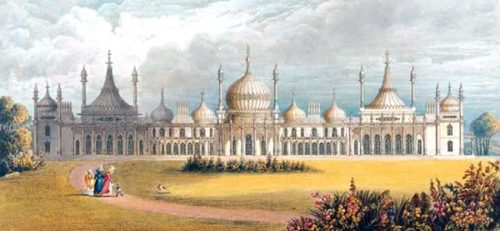
After visiting Brighton in 1783 with his uncle, Prince Henry, Duke of Cumberland, The Prince of Wales (later George IV) found an escape from the constraints of court life with his father. He was advised that the seawater and fresh air would benefit his gout, but the more diverting attractions of Brighton, lively company in his uncle’s circle, gambling, horse racing, music, theater and dining—and of course women—were probably the Prince’s primary draws to create his escapist playground there.
In 1786, the Prince rented a farmhouse in Brighton. By 1787, he commissioned the designer of Carlton house, Henry Holland, to begin what would become the Marine Pavilion Later, the Prince purchased surrounding lands to build a riding school and stables in 1803-1808.
Josh Nash, architect
After the Prince’s transition from Prince of Wales to Prince Regent in 1811, the Pavilion and its ground began a transformation to reflect its owner’s change in status. Designer Josh Nash redesigned the Pavilion with an Indo-Islamic exterior unique in the region, in a project that would extend from 1815-1822. The interior design, primarily by Frederick Crace and Robert Jones, reflected both Chinese and Indian fashion, something of a revival of the chinoiserie style of the 1740’s. The decorative choices were an example of exoticism in sharp contrast to the more classic mainstream taste of the era.
The Dragons of Brighton Pavilion
The interiors of Brighton Pavilion were distinctive for many reasons, including architecture, technological advances, and design. I’d like to focus on just one of those aspects here, the dragons. Literally hundreds of dragons grace the walls, textiles and fixtures of Brighton Pavilion. Not exactly what one might expect from the Regency era which is generally associated with neo-classical design. But the fantasy-escape offered by the Pavilion took guest out of the mundane at the first steps within.
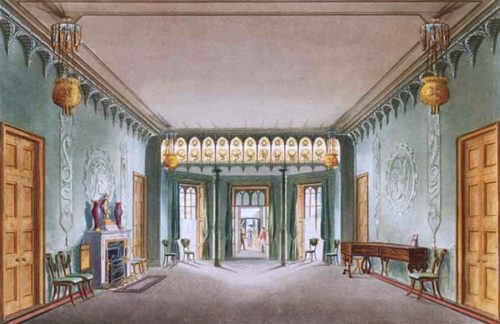
Entrance Hall
The entrance hall offered visitors immediate hints as to what might lay within. The walls bear relatively subtle images of dragons.
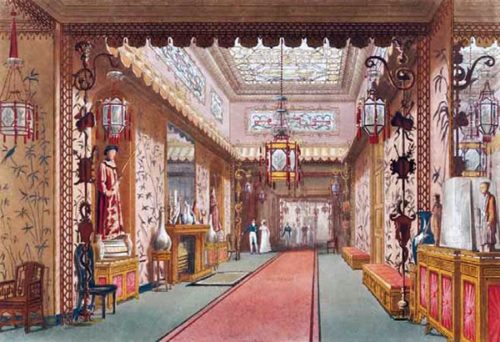
Long Gallery
The Long Gallery, sometimes also he Chinese Gallery, provided a place for guests to promenade and admire the décor. Carved and painted dragons can be seen in a close examination Nash’s illustration.
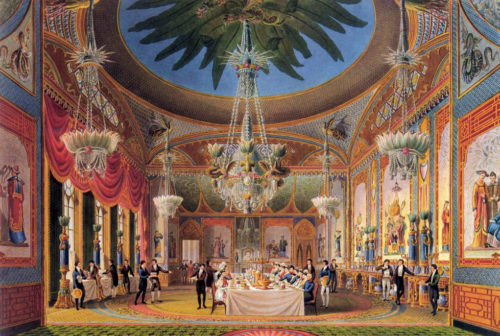
Banqueting Room
The lavish banqueting room offers equally lavish dragon decoration, perhaps most notable is the carved and silvered dragon from which the crystal chandelier is suspended. (Click this link to see a photograph of the actual silver dragon http://www.victoriana.com/Travel/images/royalpavilion-7.jpg) Six smaller dragons wind around the lotus shaped glass shades. More dragons decorate lamps, walls and furnishings.
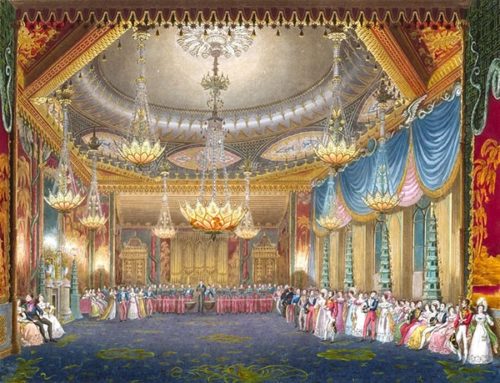
Music Room
The substantial music room is perhaps the pinnacle of the Pavilion’s chinoiserie theme. Landscape murals feature gigantic serpents and winged dragons. Dragons and serpents support the curtains for the enormous windows and decorate the gasoliers. At least 180 dragon and serpents grace this chamber.
Dragon décor can be seen in other rooms throughout the pavilion.
Don’t forget the Tunnels
One final dragon friendly feature of the Royal Pavilion were the secret corridors used by the servants, and the tunnel that ran from the north end of the Pavilion to the stables and riding house. The tunnel was lit by shafts in the tunnel’s roof that held sizeable glass lanterns tucked into the flowerbeds above the tunnel.
Of course there are rumor and myths of a more substantial network of tunnels, connecting a variety of locations to the Pavilion, but those appear to by the substance of myth.
Or maybe not. If I’m right, and dragons did inhabit Jane Austen’s England, then perhaps, just perhaps the additional tunnels were not so mythical, and the carved and painted dragons are not the only ones to inhabit the Royal Pavilion.
A virtual tour of the Royal Pavilion
You can see several of these rooms for yourself! A virtual tour of a number of the rooms mentioned here can be found at: https://brightonmuseums.org.uk/royalpavilion/visiting/virtual-tour/
References
Brighton Pavilion. Open Learn. September 8, 2012, https://www.open.edu/openlearn/history-the-arts/history-art/brighton-pavilion/content-section-0 accessed April 20, 2021
Discover the Royal Pavilion. Victoriana Magazine http://www.victoriana.com/Travel/royalpavilion.htm Accessed April 20, 2021
Moss , Richard. Forgotten Rooms And Underground Tunnels – Secrets Of Brighton Pavilion. May 24, 2004. https://www.culture24.org.uk/history-and-heritage/royal-history/tra2200 Accessed April 20, 2021
John Nash’s Views of the Royal Pavilion (1826) (All images from this source)

5 comments
Skip to comment form
A bit fanciful, if interesting. All of the cultural references at the Brighton pavilion were probably less of an international cultural appreciation and more of a celebration of empire with the prince trying to reinforce on all gullible onlookers, that set in one place, were all the corners of the exploitation. I mean empire.
Dragons are of course, cross cultural figments of people’s imagination. How else to explain huge bones found when the nomenclature for dinosaurs only existed in the 1840s? It’s interesting for the UK that their dragon cultural reference were probably a hodgepodge derivations of Anglo (probably also indo), Saxons, Roman, Celtic, Scandinavian and host of others that probably kept reinforcing themselves as a real thing, as recounted by every culture that touched its shores (before Brexit). And speaking of Brexit, there were some ignorant ones who chastised the then Labour leader in the last elections when he used the Brighton pavilion as a political platform as being “pro Islam and anti British” because he held it at “a mosque”. One feels certain that such ignorant mindsets existed in Jane Austen’s times as they do now.
I don’t care what anyone says… I believe in dragons. I believe… I believe in dragons. I… well, you know. Thanks for sharing.
Thank you for sharing this interesting pictures and history. I have seen the palace in Brighton many years ago and wondered about the architecture and was amazed to read how old it is.
Dragons are the epitome for power and resilience. This is the same in china, I have never seen so many dragons. I was there in the year of the dragon in 1988.
You see, dragons are in our life.
Thank you for sharing this interesting pictures and history. I have seen the palace in Brighton many years ago and wondered about the architecture and was amazed to read how old it is.
Dragons are the epitome for power and resilience. This is the same in china, I have never seen so many dragons. I was there in the year of the dragon in 1988.
You see, dragons are in our life.
Who actually made the Dragons that are in the pavilion and did they make any for anyone else please